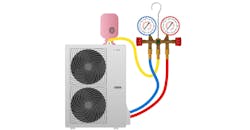HVACR Leaders to Contractors: Don’t Mix and Mismatch — Topping Off R-454B Units Could Spell Trouble
HVACR contractors across the country are feeling the pressure from a growing shortage of R-454B refrigerant. Touted as a more environmentally friendly replacement for R-410A, R-454B is a key component in many new residential and light commercial systems — but limited availability is causing significant disruptions. From installation delays and rising costs to uncertainty around future supply, HVACR contractors are facing new challenges in planning, procurement, and customer communication.
In our recent Contracting Business Refrigerant Shortage Survey, 64% of respondents are having trouble obtaining R-454B refrigerant cylinders. Fifteen percent reported not having any issues obtaining R-454B, while 5% reported having trouble obtaining R-454B equipment, and 16% reported having trouble obtaining both refrigerant and equipment. (Percentages are based on 471 responses as of June 11).
As OEM manufacturers and refrigerant producers struggle to ramp up production and find creative solutions, ACCA launched a dedicated R-454B Resource Center to help HVACR contractors navigate the current refrigerant shortage with timely, factual information and safety resources. The contractor organization also recently held a webinar addressing the R-454B shortage with a panel of industry stakeholders.
During the webinar, several contractors confirmed switching from manufacturers using R-454B to those using R-32, such as Fujitsu, Goodman, and Daikin, until the market stabilizes. However, some contractors confirmed they have no intention of ever switching back after this transition, calling the entire thing a “total failure.”
Others are taking fate into their own hands and topping off R-454B units with R-410A or removing the R-454B altogether and dropping in R-410A.
“I won't touch on the legality of it, but this product [R-454B] itself has quite a high glide,” says Jessica Wood, vice president, asset strategy, sustainability and decarbonization, Solstice Advanced Materials at Honeywell. “As you move product, it’s going to lose its composition. You’re going to go out of spec fast. From a safety standpoint, that would not be advised. Just like Honeywell would not advise topping off. Our No. 1 priority is safety. This specific product is going to separate on you — it takes a lot of recirculation to keep it in spec. If your contractors are doing that, it’s not going to be the same product they got in that 90-pound cylinder.”
Edward McFarlane, chief learning and development officer at Sila Services and ACCA chairman, notes that every third-party warranty company needs verification that systems were installed per manufacturers’ guidelines, so swapping out refrigerants or topping off with the wrong refrigerant could void the warranty.
“I’ve seen in anonymous chat groups about buying a certain type of equipment, changing the TXV, throwing in a different refrigerant, buying R-454B and dumping R-410A in, topping off and mixing the refrigerant, because, hey, there’s R-32 in there anyway,” he says. “Contractors solve problems every day. We take what is in the textbook and put it in real world applications. We have to get the customer cooling, and many people will be making decisions today to get themselves out of the woods. Some will knowingly be kicking the can down the road six months — but some may not be thinking that far ahead and are just trying to get out of the woods today. It’s fair to say you can do whatever you want, but you’re going to be holding the bag for that for however long – 10-15 years. And some of us will make that decision, some of us won’t.”
Another problem this poses is down the road on service calls, McFarlane adds. “How do we figure out when we've got weird stuff in the line? We're running a service call for something that can't keep up two years from now, and here we find out it's a bit of a Frankenstein. It's not labeled correctly because the decision we make today, our customers and our teams will have to live with for 12 to15 years.”
Jim VerShaw, chief engineer, residential HVAC and supply for Trane, stresses that mixing or swapping refrigerants is the only way to make the entire transition worse.
“If there's a whole lot of equipment out there that's been installed and they didn't put the same refrigerant in it that it was designed for, that's going to be a problem down the road,” he says. “I've heard things like taking out the refrigerant and put in R-410A. Well, odds are that's not going to run when it's hot out because the pressures are higher, it's going to go off on high pressure, and then you don't know what you got. Then, the next guy coming along doesn’t know what refrigerant he’s taking out. It's not only that, but you're going to have trouble with warranty, inspections, and with EPA because you’re violating the UL rating or certification.
Carrier also emphasizes that R-454B and R-32 are not interchangeable, according to Nick Arch. “Due to differences in composition, and system compatibility, only the refrigerant listed on the unit nameplate should be used, in accordance with Refrigerant Final Ruling (Citation: Appendix W to Subpart G of Part 82, Title 40). Using the correct refrigerant is critical to comply with these standards and avoid inspection issues”.
How It Happened
Industry leaders are pointing to the much shorter transition period as well as improper forecasting as the main reasons for the refrigerant shortage.
“Things are improving and have improved, we're at record supply of these cylinders and have been now for some time, and we're not done,” says Joe Giannetti, general manager — cooling, construction and specialty for Worthington Enterprises. “We're ramping up even further. But what do we think happened? The AIM Act, a critical forward thinking piece of the legislation of which we support because it's the right direction for the industry, but let's be honest, this policy moved faster than infrastructure. Was there communication breakdown? I don't know what we saw forecasted late last year. We thought it was very low compared to what we think might happen. So we ramped up, but it did come on much stronger than anticipated.”
Arch says Carrier began ramping up production last year to prepare for the transition, and from Carrier’s perspective, there is not a shortage on equipment. “We recognize that we can make as much equipment as we need to, but the challenge is then for installations. The impact from a contractor standpoint is tremendous. We saw a tremendous amount of sell-through of the R-410A product in Q4, and frankly in Q1, which exacerbated the overall ramp up requirements… so that obviously created a little bit of the pinch we're experiencing, but to Joe's point, we’re continually seeing steady improvement to make sure we're getting ourselves out of this as quickly as possible.”
What’s Happening Now
Chemours has seen a sizeable increase in orders as one of the suppliers of R-454B, notes Graham Pratt, Americas senior business director, Thermal & Specialized Solutions, for Chemours.
“We’re seeing improvement — we’re doubling our capacity, we put on a third shift at one of our downpacking facilities,” he says. “We’re getting product out. I would suggest for those using our Opteon brand to go to opteon.com to see where to buy it now — the list is actually updated to show where the product is. We know we're getting it to our distributors and they're working hard to get it down to the contractor level.”
After Honeywell saw the demand spike early this year, the company went to its global supply chain to see what it could do to resolve the issue, Wood notes.
“We increased our hiring by 30%,” she says. “Our blending and downpacking has increased 44%, and we're committed to doubling our capacity by the end of the year. We’re continuing to look at every opportunity that we can to get more product out to our channel partners as quickly as possible. We're working directly with our OEMs, some of those on the phone to make sure that when they're getting the units out, they have the maximum charge so we can ensure contractors have what they need. One thing that we are doing at Honeywell in June is making sure that all of our channel partners that have orders in, that everyone will get some product. We're making sure that we are feeding as many as possible here. That is our commitment through June.”
Honeywell is also working with OEMs as they set up downpacking facilities to ensure safe handling of the product, Wood notes. “We're really trying to work across the board with everyone to make sure everyone's getting product, and we're all getting it safely.”
In addition to Carrier, Trane, Rheem, and York all announced they would increase the refrigerant charge in R-454B equipment at no additional cost to contractors until the problem is resolved.
Arkema also announced that it would be entering the R-454B market as well.
“Having more suppliers in the market is always a good thing,” says Scot Swan, business manager, refrigerants for Arkema. “It should help the issue in the medium term.”
Swan adds that Arkema’s R-454B product should be available “soon.”
Many contractors complained the webinar offered no real or immediate solutions to alleviate the problem.
“Some people were hoping for, ‘Hey, all the refrigerant is at 123 Made Up Street, go get it,’” says McFarlane. “That’s not something we can provide. We understand people don’t like the situation that led to this. If you think the situation sucks, join ACCA, and make the difference.”
About the Author

Nicole Krawcke
Nicole Krawcke is the Editor-in-Chief of Contracting Business magazine. With over 10 years of B2B media experience across HVAC, plumbing, and mechanical markets, she has expertise in content creation, digital strategies, and project management. Nicole has more than 15 years of writing and editing experience and holds a bachelor’s degree in Journalism from Michigan State University.
